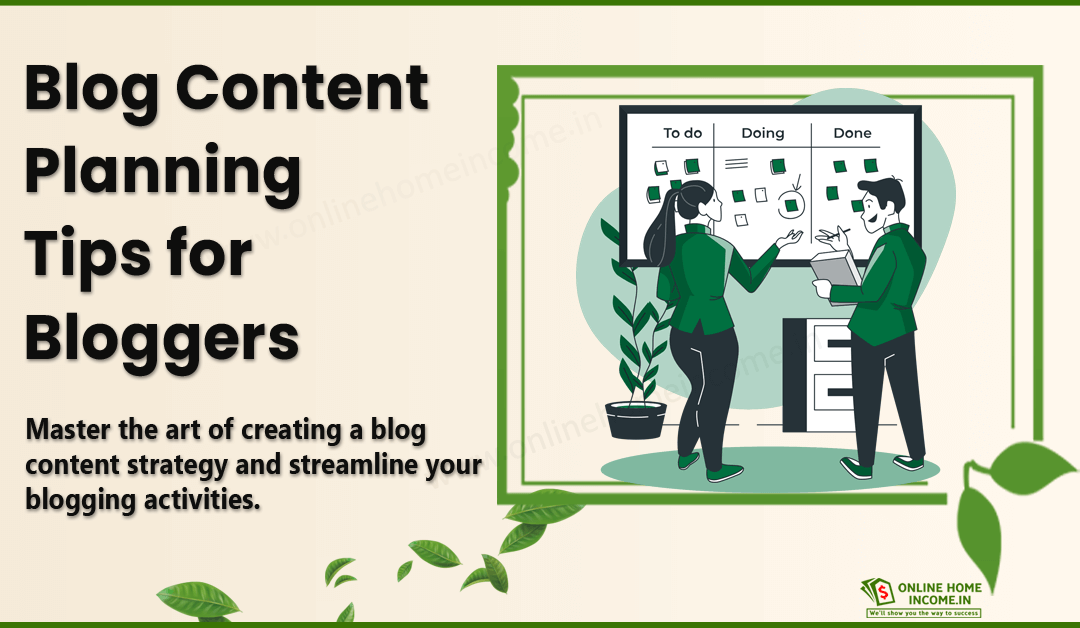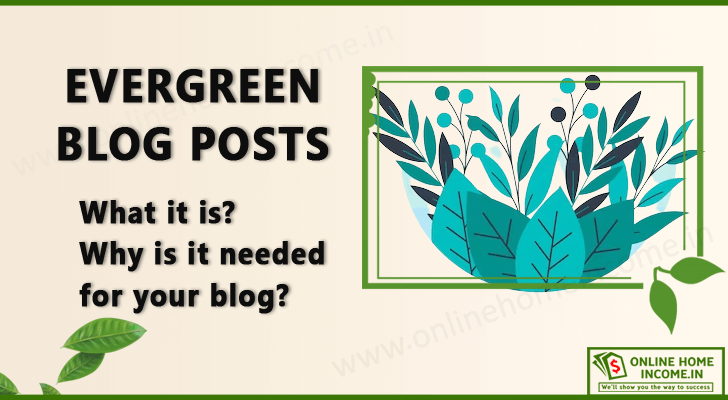When starting a blog, your main aim must be to provide quality content. Here, I will share some tips to write a good blog post from my blogging journey.
You feel you have experiences and learnings to share with a sizable audience. Then, blogging is your best choice. This field gives you a widespread reach like no other media.
However, the world of blogging is huge. With basic literacy and experience, anyone can blog and provide solutions to existing problem statements. It is a highly competitive field, as new bloggers come every day.
To be on the top of this race, it is important to write a good blog post regularly. Ultimately, it is good quality blogs that make it to viewers.
- Quality content is the top parameter that search engines seek to rank your blog higher in SERPs.
Only if your blog manages ranks on the top search results can your money-making plans set off. Ensure your blogging dreams turn into reality by planning to publish quality blog posts.

⇒ Does $10 a day in your bank will make you happy? If so, here is an exciting opportunity for you to start free.
⇒ All you need is a Smartphone with an Internet connection. | Join today!
Writing on random topics will not establish you as a credible blogger. Search engines give importance to EEAT (Experience-Expertise-Authority-Trustworthiness) metrics when ranking pages.
It means that content that provides rich firsthand experiences and expertise gets more priority. It helps filter out repetitive and spam content to help viewers locate the exact information they seek.
How do we arrive at this expected content quality?
I will share some experiences that helped refine the way I started writing a good blog. It is a slow process, but with practice, you can ace it with ease.
What is a Blog Post & What Makes a Good Blog Post?
The blog post is a (web)log you make in your domain or website giving information on a particular niche. It includes rich text complemented by images, infographics, YouTube videos, social media links, etc.
- Blogging started as a hobby for many who wish to share recipes, travel experiences, parenting hacks, exam tips, etc.
- Services like Google Adsense allow people to monetize their blogs with minimal investment.
As bloggers started seeing surges in viewers, they started eyeing more organic ways to improve their traffic.
— Guest blogging, social media marketing, paid partnerships, affiliate marketing, etc., are hot trending topics in the blogging world.
Blogging in your business domain gives your business the best boost in terms of customers and revenue.
— Regularly creating a good blog post relating to your company mission, products, USP, etc., establish yourself as a brand that is here to stay.
Contents of a Good Blog Post
To achieve organic traffic and blog revenue– it is mandatory to maintain the quality of content.
Let us see the structure of a good blog post;
- A catchy headline followed by a feature image/infographic should be the first sight seen by the reader.
- The author and publishing time details show the credibility and relevance of your blog.
- Start with a good introduction, what to expect in the blog post, and then define the clarity of the problem statement.
- The blog post must have detailed solutions and practical experiences.
- Finally, include Call-to-Action prompts and conclusive statements.
Try to maintain the same skeleton when writing a good blog article (as per your content calendar).
10 Tips [from my Experience] on How to Write a Good Blog Post
You may have a lot of data to be shared online. But will it be able to reach your target viewers? This pathway of making it to those who seek your solutions is very tough.
Thanks to Google Search Engine Optimization (SEO) metrics, many filters are applied to deliver only rich and good-quality blog posts to reach viewers.
Structured blog posts with rich content that meet EEAT standards have high chances of ranking at the top of SERPs.
Creating successful blog posts requires proper research and planning. Here, I will share a few strategies that helped me become a successful blogger.
1. Select the Right Topic for Your Blog Post
The first step to starting a successful blog is to be clear on what you will be writing about. You can choose any blogging niche based on your passion or profession.
However, writing without a specific purpose will not bring any results.
When people view your post, they will browse through other posts in your blog. Making random and irrelevant posts according to trends can tarnish your credibility.
Post content-rich blog posts regularly on a focused problem statement in your selected blogging niche. Through this, you establish your authority as a domain expert.
How do you choose the right topic to blog on?
Start with researching profitable blogging niches. Social media, Google Trends, Google Search, etc., are spaces where you can get trending topic ideas. This way, you will come to know what your target audience is searching for.
- Find what it is that is lacking in that area.
Analyzing the top blogs in your chosen domain will give you blog topic ideas to write a good article. Choosing new topics is a key to being ranked high by search engines.
Like how you try to understand your target audience’s needs, you will also have to analyze how they are.
- What age group and geographical locations do they belong to?
- What are their literacy levels? Can they understand technical topics?
- How can you reach out to them to promote and get feedback for your posts?
With your audience’s nature and clear problem statements in your domain, start planning out the topics of your blog posts. Structure them according to the order of publishing.
2. Perform Keyword Research
Every post on your blog needs to have a focus keyword or keyphrase. It is this focus phrase that justifies the worthiness of your blog topic.
It is an important step that involves deep research.
In this process, you will find the keywords typed by users in the search bar to be able to land in your blog.
In short, your keywords must get your blog a top rank in search results and take your blog to your expected audience.
Your keywords must reflect the mindsets/expectations of your analyzed target audience.
As discussed above, Google has some tools like Trends, AdWords, KeywordPlanner, etc., to carry out trending topic-wise keyword research.
Then, you must get the search volume for the chosen keywords. Tools like SEMRUSH, AHrefs, etc., can help you analyze how much traffic your competitors are receiving for these keywords.
Elucidate primary/focus keywords and secondary keywords for each blog post.
When you write a good blog article, it must be around the focus keyword that denotes your problem statement.
2.1. Best Practices for Keyword Research
It is the most important step to follow when you write a good blog post.
Keyword usage in your posts can fast-forward or preempt your blogging journey.
I recommend the following keyword quality guidelines that I follow religiously;
- Always aim for a Keyword volume of 100-1000 searches a month.
- Create a keyword cluster that includes a minimum of 1 focus keyword and 4-5 secondary keywords.
- Ensure that the keywords have enough demand and match user intent.
- Be in the shoes of your target audience. Imagine and list what they would type in the search bar to query your blog.
- Keep tracking the popularity of your keywords. Always have backup keywords to replace those that can go out of trend.
- Use tools like SEMRUSH, AHrefs, etc., to analyze how your competitors are targeting keywords and using them to attract organic traffic.
With these in hand, you can start with the foundation of your blog post.

3. Create a Blog Post Outline
After choosing the blogging topic and doing the market analysis (a.k.a. keyword research), create a structure for a good blog post.
- You need to create the Table of Contents for every blog post you write.
Begin this process by doing a Google search with your focus keywords.
Example: The focus keyword is the “best clubbing hangouts in Chennai.“
— You will be able to see the topics and subtopics covered by top blogs competing for the same keyword.
— Such competitor analysis gives you an understanding of expected article templates, length, multimedia added, etc.
As a blogger, you must avoid the same content and include some new topics or areas that are undiscovered by clubbing enthusiasts.
Repeat the same process with your secondary keywords. I follow the following structure of topics when writing a good blog post.
It has consistently given me great results;
- Start with a short introduction giving insights on what to expect.
- Describe the problem statement.
- Briefly explain how you will be providing solutions.
- Create subtopics to describe each solution in depth.
- Suggest practical examples or share personal experiences.
- Conclude with convincing statements that your solutions are just perfect for your viewers.
Maintain a word count of 200-250 for each topic to ensure visual uniformity. To achieve this, section your content into topics and subtopics.
Make sure that the topics’ content does not deviate from your focus keywords.
4. Understand SEO for Writing Blog Posts
Before elaborating on your blog posts, you must learn/revise SEO guidelines for writing a good blog.
Search engine crawlers look for on-page SEO metrics in blogs – when computing their SERP rank.
Such metrics focus on the quality of blog content and keyword placements.
- Placing primary and secondary keywords at strategic locations in your blog post sends positive signals to search engines.
- Optimizing the meta title and meta description with the focus keywords is crucial to signal search engine crawlers.
The crawlers index your blog post on search results based on these keywords and their relevance to user queries.
Some important places to include the keywords are;
- Blog title,
- Post URL,
- Topic headers,
- Image ALT texts,
- First 100 and last 100 words.
Maintain the keyword density between 2% to 2.5%. The more organic your keywords appear in these locations, the higher your chances of ranking at the top of search results.
The way you write your posts must be as if you are talking to a friend. This storytelling format or experience-sharing perspective is seen as a positive SEO signal for blog posts.
4.1. Mandatory On-Page SEO Metrics I Follow
- Add meta titles and meta descriptions for all your blog posts.
Meta Title: This is the first element that helps search engine crawlers understand your blog topic. It can be up to 55-60 characters, mandatorily including your focus keywords.
Meta Description: This is a short description that appears below your meta title when listed in SERPs. Users get a gist of what your blog covers, and finding the target keywords in this area increases CTR.
- Place focus keywords in strategic locations like blog titles, header tags, and image alt texts organically.
- Content quality plays an equally important role like keyword matching. Writing long and in-depth blog posts with ~2500 or more words is a crucial SEO factor that I have followed. Such long posts are valued by search engines as credible and informative.
- Be sure to meet EEAT standards. Engaging and original blog posts always have a higher value than descriptive or journal-style articles.
- Include inbound links to posts within your blog. Keep them limited to prevent distractions.
- Provide links to your author bio, privacy policy, contact pages, etc., in your blog. Such links show that your blog post is credible enough to be listed at the top of SERPs.
5. Structure Your Blog Post
The template to write a good blog post must be easy for your target audience to perceive. The elements of your blog must follow a template that best suits your problem statement.
— The general rule of thumb is to start with a brief introduction. Follow this with a clear problem definition. Then, move on to providing solutions.
Tip 1.
Before starting with suggestions/hacks/solutions, you must ensure that your audience is familiar with the prerequisites.
If viewers do not find explanations for something they are unaware of, they may go to other blogs to learn about it. They may or may not come back if they find other posts describing what they expect.
Tip 2.
Bounce rate refers to the number of times readers leave your page after going through it partially, without exploring your whole post.
A 40% bounce rate or lower is desirable for a good blog. Readers do not need to switch between tabs frequently when reading your blog.
Tip 3.
Keep your content scannable. So that readers should understand the format in which you describe each solution.
You are writing a blog post on busting myths about beauty parlors. Make every myth busted as a subtopic.
Within each subtopic, include the following template;
- What is this myth about?
- Why did it come in the first place?
- Does this have scientific proof?
- How do you suggest to overcome this?
Although blogs need to follow a storytelling format, try improving your readability.
Break down long paragraphs into shorter ones and add new subheadings if necessary.
For instructive suggestions, add bullet points. Highlight important details in bold.
6. Attract Readers with a Great Introduction
When a user lands on your blog, grab their attention within 5 seconds. The first few sentences of your blog can make readers continue further or close and move to another result in the SERPs.
It is where I stress upon writing a catchy introduction.
I always recommend keeping your focus keywords within the first 100 words and last 100 words to keep your viewers in sync.
Be sure to come up with a crisp and brief introduction when you write a catchy blog post.
The introduction is a valuable part of the structure of a good blog post. Adding a question or a hook (in the beginning) is a known way to stimulate curiosity among readers.
Remember that with your focus keywords, anyone can locate your blog.
They may be interested in the topic you write about but are not aware of the prerequisites. Some may want to skip what they already know and would not want too much content.
So you will need to cater to all kinds of audiences.
Therefore, write the introduction with the right amount of details. A few sentences covering the basic concepts and more topical in-depth can be an ideal introduction.
The whole point of having an introductory section is to keep your readers hooked. So be less informative, moderately interactive, and highly optimistic that your blog has what they are here for.
7. Write Casually (As You Talk to a Friend)
Writing a good blog post doesn’t require grammar and professionalism in your language. Remember that this is not a piece of literature, a journal, or a newspaper article.
Blogs are friendly stories or posts that you make to share your learning, experiences, and expertise.
You could be blogging on any topic. From explaining how to build a rocket to teaching how to cook idly, anyone must be able to understand and do it. That is the beauty and versatility of blogging.
When you talk to a friend (who seeks advice or suggestions), you will already have an idea of what they know, their grasping abilities, etc.
You would curate your suggestions to suit their way of life, budget, etc. Anticipate what queries they may come up with, what other doubts or relevant learnings they may need to understand, etc.
It is one of the reasons you need to know and research your audience.
- Know their preferred language, jargon, how much time they can pay attention, etc., and prepare your blog presentation accordingly.
- Sometimes, your focus keywords can be modified based on local slang. The solutions you give may be more personalized to suit your target audience.
- Your audience can have beginners, intermediates, or experienced people. It means you cannot skip giving the required briefs or pre-requisites when you write a good blog post.
Make your blog navigable and friendly for regular/experienced readers.
8. Write from Your Heart to Bring a Solution
Now you have a topic to write about. You are aware of your experience and knowledge. With proper research, you have your required keywords, demand, and the format structure for your article.
A huge chunk of writing a good blog lies with proper keyword and audience research. However, the success of your blog purely lies in how original and unique your blog posts are.
Search engines (as well as readers) give a lot of importance to first-hand experiences in rich blogs.
- Like how I am writing this blog from my experience, make sure to share your original experiences without cooking up stories.
As a blogger, I faced a lot of hardships in my initial days.
Balancing a full-time job while also giving regular content was challenging. However, I slowly learned the art of mastering how to make my blogs reach a large audience.
Sharing what I learned in this journey helped me handle a lot of struggling bloggers. It has helped many to rethink their decision to quit blogging.
I vow to myself that every part of my articles talks about finding a solution and solving the given problem statement.
Therefore, write blogs to appear like a hearty conversation, giving a sense of optimism to your readers.
9. Add Media & Illustrate with Examples
My blog posts are read by many people who belong to different interests.
A specific target audience may be interested in your blogs, say, recipes to cook without cooking gas.
But they may not be literate to read through your whole blog. Or they may not be able to spend time reading.
To cover all groups of people in your target audience, include multimedia when you write a good blog post. It is crucial to craft an engaging blog that deserves a rank on the first page of search results.
- Images, YouTube videos, Infographics, Charts, etc., can make your blog well-received by all kinds of audiences.
- Create YouTube videos by using a simple slideshow with images or screenshots. This way, your blog and YouTube channel can get more traffic.
- The cover image (or a main image) for every post helps your blog stand out in SERPs. Such images are displayed under the “images” tab of search results. For those who prefer searching images over text, having such images can make your blog reachable.
Image-based social media like Pinterest rely heavily on multimedia and images in blogs.
Depicting solutions through flowcharts and adding GIFs can make your blog look attractive.
Suggesting first-hand or real-life practical examples can make one understand your concepts easier.
Since blogging is more of an informal way of learning, adding a lot of examples to cover all categories of audiences can boost your traffic multifold.
10. Ask Readers to Take Action [Add a CTA]
A good blog post is built on a specific purpose. You define a problem statement and follow it with a list of solutions or suggestions.
By the end of your article, your readers must be motivated positively to do whatever you have suggested.
Call to Action (CTA) statements are mandatory in the conclusion when writing a good blog post.
Successful blog posts are those where users immediately take action upon reading your blog.
For example;
You write a blog reviewing a product. Provide your verdict in the end and share the product purchase links.
When users go to the product page and proceed to the payment portal, your blog has achieved its purpose!
Such CTA prompts form the building blocks of monetizing from your blog.
— Whether it is collecting an email, redirecting readers to sales pages, triggering readers to buy affiliate products, etc., including a CTA is mandatory to fulfill the purpose of your blog.
While invoking CTA is the ultimate intention of any blogger to grow traffic and get revenue, the process needs to be organic. The experiences, learnings, and reviews shared must be true and first-hand.
Decide on the kind of CTA that you would require for your blog.
For the kind of blogs I write, I encourage my readers to follow my social media handles for regular updates and tips.
I collect the emails of budding bloggers to publish newsletters and notify them regarding my master class, 1-1 sessions, etc.
A Few Examples of Good Blog Posts
Since I have shared my hacks to write a good blog post from my experience, I will share some of my blogs.
Try to recollect all the points I have mentioned above. Identify the focus keywords and how I have used them periodically in my posts.
Blog Post 1.
Title: 8 Breakthrough Tips to Research for a Blog Post in 2024
Here, I have covered what and why it is important to research for every blog post that you write. Look at the examples that I have shared. Observe how I ask questions and add hooks right in the beginning.
Blog Post 2.
Title: Beware of Online Survey Scams – 6 Tips to Spot Them
Notice that the focus keywords are added to the blog post URL. It is yet another on-page SEO strategy I apply. I discuss how one can spot scams, and dissect them based on their type, and protect ourselves from becoming victims. Observe that, I follow the same template structure showing the problem, how to solve it, and how you can do it.
Blog Post 3.
Title: Is Blogging a Good Career in India in 2024?
Another post highlights exactly how much bloggers are earning in a month. Such highlights make it to Google’s Q&A style results come at the top in SERPs. It would prompt users to click your page, believing that your page has what they expect.
Blog Post 4.
Title: Can You Blog If You Can’t Write? 14 Tips to Help Non-Writers
Here, I give a lot of examples under each topic, showing how easy it can be for a novice writer to become an expert blogger.
I try to keep my blog posts organic with the right content framed from my experiences with proper research and analysis.
Is that All to Make a Good Blog Post?
So far, I have shared some of the best practices to follow to write a good blog post.
- Do you think it is enough to make it big?
- Are you in a confusion?
Researching your audience and keywords is something inescapable for any blog post.
Whether you are a beginner or an experienced blogger, you need to perform this step and keep yourself updated with time.
- Following a uniform blog structure, outline, and on-page SEO can enhance your blog’s ranking.
However, these factors are not sufficient to publish successful blog posts.
- Every blog post you write must have a unique and personalized touch.
- It is where you describe first-hand experiences learned in your blogging niche.
These are the deciding factors for readers to go ahead with your blog.
A unique writing style can grab eyeballs and make people visit your blog frequently. Although blogging is informal and anyone can follow their style, it must be readable and scannable.
It must be a reflection of your approach and describe each of your solutions or suggestions.
In the end, your readers must be prompted to take the action (that you intend to make them do). It marks the success of your blog post.
If you wish to have more handholding in addition to my tips here, feel free to reach me. Get started with your blogging journey today! I would love to see all the great content you will be coming up with.







